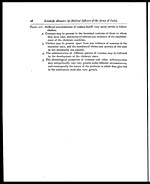Medicine - Institutions > Army health reports and medical documents > Scientific memoirs by medical officers of the Army of India > Part X, 1897 > 2 - Notes on the malarial parasite as observed in the blood during life, and in the tissues post-mortem, at Lahore, Punjab
(35) [Page 29]
Download files
Individual page:
Thumbnail gallery: Grid view | List view
![(1) [Page 29] -](https://deriv.nls.uk/dcn17/7500/75003149.17.jpg)
Notes on the Malarial Parasite as observed in the blood
during life, and in the tissues post-mortem, at Lahore,
Punjab.
BY
SURGEON CAPTAIN J. MURRAY, M.B.,
PROFESSOR OF PATHOLOGY, LAHORE MEDICAL COLLEGE.
So much valuable literature has appeared on the subject of the malarial
parasite within the past few years, and so much of an authoritative character
has been written by observers who have devoted a large part of their time and
energies entirely to this work, that some excuse is necessary for venturing
to publish a report on investigations that are necessarily comparatively meagre
and unimportant. My apology for doing so lies in the fact that, so far as I
know, no definite statements have as yet been made regarding the biological
characters of the parasite as met with in India, in the light of the compara-
tively recent work of Golgi, Marchiafáva, Bignámi, Mannaberg, and other
observers, chiefly of Italian experience.
From the time of the discovery by Laveran in November 1880, of the so-
called Plasmodium malariæ, up to 1885, it was generally held that the parasite
met with in all cases of malarial fever was the same, and that the various forms
described by Laveran were, in all probability, but protean varieties of one species,
the life history of which was not known. No morphological or biological
distinctions were noted between the forms associated with the various clinical
types of malarial fevers. In 1885, however, Golgi was able to detect the pre-
sence of a distinct type in ordinary tertian, and another in quartan fever.
He was also successful in tracing the development of the parasite from a very
minute to a large sporing body, and in proving that the sporulation of one
generation of the mature parasites coincided with the febrile paroxysm. Some
time later, Marchiafáva and Celli, Canalis and others, following the lines of
investigation origainted by Golgi, confirmed his results as regards simple tertian
and quartan fevers, and, in addition, succeeded in proving to their own satisfaction
and to that of most unbiased critics, that these parasites, in their turn, differed
from those of quotidian fevers, and of the grave forms of malarial intermittents
and remittents to which they gave the name of " Summer Autumn Fevers."
During this period of progress, Laveran, the discoverer of the parasite,
maintained his original position, holding that the organism did not differ suffi-
ciently in the various clinical types of fever to warrant its division into distinct
varieties or species. In his book "Du Paludisme, " published in 1891, he sums
up his observations on the point by the following remarks:—" Tous ces faits
Set display mode to: Large image | Zoom image | Transcription
Images and transcriptions on this page, including medium image downloads, may be used under the Creative Commons Attribution 4.0 International Licence unless otherwise stated. ![]()
| Permanent URL | https://digital.nls.uk/75003147 |
|---|
| Shelfmark | IP/QB.10 |
|---|---|
| Additional NLS resources: | |




